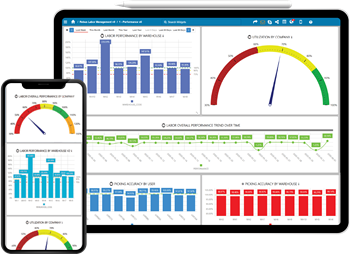Five Benefits of Real-Time Data in the Warehouse
If your business wants to deliver superior experiences, retain customers, and innovate rapidly, you need faster access to the value contained within your data. That’s what real-time data in the warehouse can do for you.
We live in an age when customers don’t just want things fast, they expect them instantaneously. They want immediate delivery updates for an order they placed a minute ago, and they want their music app to instantly understand the type of songs they like.
Buffering screen? No thanks.
It’s not just customers. As a business, you want to understand your customers faster and automatically tailer their user experience. You want to track sales, inventory, and customer onboarding immediately.
Yesterday’s data delays won’t cut it in today’s warehouse. You need to shift your approach and technology to access data in real-time.
Accessing real-time data in the warehouse involves the continuous process of loading data into a warehouse and making it instantly available to the different business functions that require it.

In a traditional data warehousing approach, data is loaded in batches overnight or on hourly schedules from source systems. But real-time data is available within minutes, if not seconds.
Having up-to-date information at your fingertips is a game-changer for businesses and offers these significant benefits.
Real-time data in the warehouse enables you to consolidate data from different sources, extract insights from them and leverage them to make strategic business decisions faster.
In a real-time connected network, you can refresh data from all the systems in your warehouse in real-time and set reports to run on an as-needed basis. This saves the time required to generate reports and analytics for more agile decision-making.
According to a McKinsey survey of more than 1,000 organizations, executives spend 37 percent of their time making decisions, and more than half of this time is wasted. For managers at an average Fortune 500 company, this could translate into more than 530,000 days of lost working time and roughly $250 million of wasted labor costs per year.
Before moving to a real-time data warehouse, global ecommerce logistics company, Pitney Bowes had to rely on daily overnight batch processes to consolidate inventory and sales data. This meant they were unable to make important personnel and cost decisions regarding the orders being fulfilled.
When they switched to real-time data warehousing, Pitney Bowes could consolidate that data in real time. This helped them understand how to make business decisions immediately rather than waiting for information from the previous day to come through.
Providing access to real-time data for everyone starts with enabling data to be rapidly ingested and spread across the network. Having real-time data then has cascading benefits for everyone across the company.
A real-time data warehouse can also be connected to data visualization tools to serve sales, finance, customer service, and marketing teams.
Similar approaches can be applied in quite different scenarios. For example, real-time reports of traffic conditions and weather forecasts can help logistics companies route delivery trucks more effectively. If those trucks are refrigerated, onboard temperature sensors can also monitor for issues requiring immediate attention or rerouting and send real-time alerts.
You can also use real-time analytics to monitor incoming orders and product availability so you can move quickly to increase supplies that are running short, and to detect the need for short-term contract labor if production, packaging, or shipping is falling behind target.
A leading American furniture store, Conn’s HomePlus, was looking for a solution that would help it increase labor productivity across its distribution centers. Conn’s faced challenges with time-consuming datapulls and a lack of visibility into real-time labor metrics. These data pulls were tedious and often resulted in historical, unusable data.
The company struggled with tracking and managing productivity in real time. One key metric, Pieces per Hour (PPH), required extensive time to collect and view—and still could only be viewed historically. Without real-time visibility, operations and employees didn’t have the opportunity to proactively course-correct to meet their established goals for performance.
They needed a solution that would provide real-time insights into labor performance, productivity, and throughput to better manage employees and operations. For the solution to work for Conn’s, it also had to be easy to use, flexible, and provide complete visibility into operations in real time. They found a solution with real-time data from Rebus.
Real-time data means your warehouse can respond to changes faster. Reduced lag in data means you can be more agile and take advantage of opportunities faster. That can boost your efficiency and help you meet your revenue and profit goals.
For example, if you own an ecommerce website running a Black Friday sale, real-time data warehousing can allow for immediate adjustments to advertisements and sales prices by gaining real-time insight into customer and market data, thereby improving profitability.
It also means you’re much less likely to sell something that’s out of stock and end up with an unhappy customer. Which brings us to the fifth benefit.
Real-time data allows you to avoid out of stock and excess inventory more quickly than a periodic inventory management scenario. By updating all receipts and sales in real-time, you can tap into up-to-the-minute data, which will enable you to more effectively budget supply and demand for all products.
One of the worst-case scenarios is to have a ready, able, and willing buyer, only to lose them because you don’t have adequate stock of a particular product. Not only does this impact your immediate sales but it may also have a negative impact on future sales.
Linking real-time data to your inventory system will also bring some benefits to your accounting and finance teams. It will result in less overall recounts of inventory if managed correctly and will provide a way to track return products. Knowing exactly how much inventory you need at the right times gives an accurate picture for the finance department.
Bringing Real-Time Data Together
A good WMS is the first step in gaining access to your data. But to get your data in real-time, without complicated processes and SQL queries, you’ll need software that gives you clear visibility into your WMS.
There are multiple solutions that give you data in real-time, but only one that can take data from your WMS and disparate systems across your supply chain and bring them together in one dashboard.
The Rebus Platform is a warehouse technology solution that provides extended, purpose-built solutions for teams whose digital strategy has outgrown the capabilities of their WMS.
While WMS is focused on the core functions of running the warehouse, Rebus is designed to harmonize the data of single or multi-site networks and provide powerful extended capabilities in real-time for operators during their shifts.
And by connecting disparate systems across the corporate distribution network, logistics professionals have unparalleled access to view, manage, and compare their global warehouse network like never before.
Rebus gives warehouse operations leaders the real-time power to lead.
Speak to an Expert
